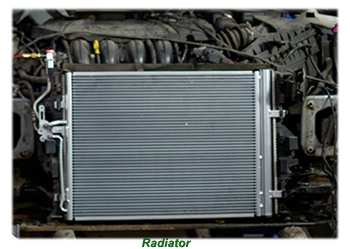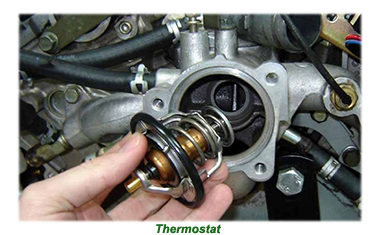
 The function of a cooling system is to maintain a vehicle’s operating temperature at a constant and safe level. During the internal combustion process heat builds up in the engine. Sometimes to excessive if not dangerous levels in its cylinders.
To keep heat levels in check a coolant/water mixture is circulated around the cylinders inside an engine block.
The function of a cooling system is to maintain a vehicle’s operating temperature at a constant and safe level. During the internal combustion process heat builds up in the engine. Sometimes to excessive if not dangerous levels in its cylinders.
To keep heat levels in check a coolant/water mixture is circulated around the cylinders inside an engine block.
Typically, an engine cooling system utilises a combination of gaskets, hoses, fans, fan clutch and belt, engine block and heads, thermostat, the radiator and water pump.
 The fans and the radiator remove excessive heat from the engine by circulating the coolant through a series of hoses to hold the temperature constant. Constant exposure to excessive temperatures could damage the engine permanently.
The fans and the radiator remove excessive heat from the engine by circulating the coolant through a series of hoses to hold the temperature constant. Constant exposure to excessive temperatures could damage the engine permanently.
 The components required for a cooling system in a typical automobile include the radiator, which helps dissipate heat from the engine, and the proper balance of fluid, which is usually a mixture of water and coolant.
The components required for a cooling system in a typical automobile include the radiator, which helps dissipate heat from the engine, and the proper balance of fluid, which is usually a mixture of water and coolant.
 Additionally, there is the water pump, responsible for circulating the coolant throughout the system, the thermostat, which regulates the temperature of the coolant, and the fan, which helps cool the radiator by drawing air through it. Every car owner should prioritise several maintenance precautions to ensure the longevity and optimal performance of their much cherished vehicle.
Additionally, there is the water pump, responsible for circulating the coolant throughout the system, the thermostat, which regulates the temperature of the coolant, and the fan, which helps cool the radiator by drawing air through it. Every car owner should prioritise several maintenance precautions to ensure the longevity and optimal performance of their much cherished vehicle.
To ensure that a classic car cooling system is functioning properly, you can perform the following steps:

 It is important to use the correct type of coolant to match the mechanical system of the classic car. Refer to the owner's manual or ask a mechanic for the recommended type of coolant.
By following these tips and regularly maintaining your classic car's cooling system, you can help prevent overheating and keep your car running smoothly.
It is important to use the correct type of coolant to match the mechanical system of the classic car. Refer to the owner's manual or ask a mechanic for the recommended type of coolant.
By following these tips and regularly maintaining your classic car's cooling system, you can help prevent overheating and keep your car running smoothly.




